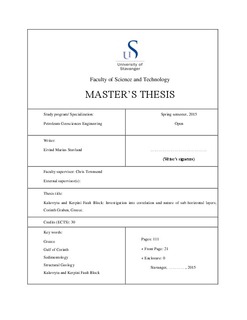| dc.contributor.author | Stuvland, Eivind Marius | |
| dc.date.accessioned | 2015-09-17T12:32:11Z | |
| dc.date.available | 2015-09-17T12:32:11Z | |
| dc.date.issued | 2015-06 | |
| dc.identifier.uri | http://hdl.handle.net/11250/300564 | |
| dc.description | Master's thesis in Petroleum geosciences engineering | nb_NO |
| dc.description.abstract | The Gulf of Corinth is located in West-Central Greece and is the result of a Pliocene-Recent, asymmetric extensional rift system. The region offers an excellent opportunity to study rotated fault blocks and the various syn-depositional sedimentary environments that form within them. The focus area for this study are the two fault blocks: Kerpini and Kalavryta. These two fault blocks were studied in order to map a series of sub-horizontal sedimentary layers found in the two fault blocks, ascertain their nature, determine the relationship with each other and the relationship with surrounding sediment (which usually has a moderate to steep southward dip). Previous studies in the area have neglected to address the sub-horizontal sedimentary layers, and have classified them as basal conglomerate (Ford et al., 2013). In order to fully understand the sub-horizontal layers (assumed to be younger), the underlying sediment had to be mapped. Geological maps were created of the study area, mapping both structural and stratigraphic features. Maps were digitized and the data was later analysed with the aid of numerous images recorded in the field.
A total of 8 separate outcrops of sub-horizontal sediments have been identified; 2 of these were later dismissed as ‘dipping’ sediment during analysis. This was based on dip angle/dip direction and flow direction within these two units. The remaining 6 units have been correlated based on location, flow direction and texture. The lower-lying (older) sediment was determined to be part of a massive alluvial fan that originated from the Kalavryta Fault, flowing N/NNE, covering the area. This study places the lower-lying sediment to pre-Kerpini Fault. The sub-horizontal layers (late-syn / post Kerpini Fault) have a more fluvial character and show an E/NE flow direction, entering the fault blocks from the SW and are assumed to flow towards the Dhoumena Fault Block, but not continuing east towards the Vouraikos River. This study has provided a new model on the sedimentation of the Kerpini Fault Block by addressing a problem that was not previously answered. Additionally, it contradicts some pervious ideas about the development of the Kerpini Fault Block. | nb_NO |
| dc.language.iso | eng | nb_NO |
| dc.publisher | University of Stavanger, Norway | nb_NO |
| dc.subject | Greece | nb_NO |
| dc.subject | Gulf of Corinth | nb_NO |
| dc.subject | Kerpini Fault Block | nb_NO |
| dc.subject | petroleumsgeologi | nb_NO |
| dc.subject | petroleumsteknologi | nb_NO |
| dc.subject | petroleum geosciences engineering | nb_NO |
| dc.title | Kalavryta and Kerpini Fault Block: Investigation into correlation and nature of sub-horizontal layers; Corinth Graben, Greece. | nb_NO |
| dc.type | Master thesis | nb_NO |
| dc.subject.nsi | VDP::Technology: 500::Rock and petroleum disciplines: 510::Geological engineering: 513 | nb_NO |
| dc.subject.nsi | VDP::Mathematics and natural science: 400::Geosciences: 450::Petroleum geology and petroleum geophysics: 464 | nb_NO |
